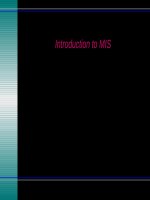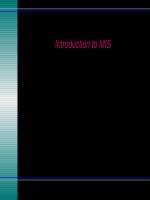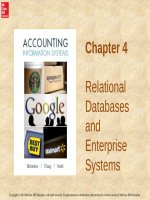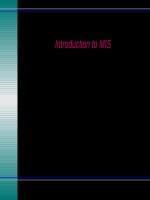Lecture Management information systems - Chater 12: Developing business/IT solutions
Bạn đang xem bản rút gọn của tài liệu. Xem và tải ngay bản đầy đủ của tài liệu tại đây (1.61 MB, 74 trang )
Copyright © 2006, The McGrawHill Companies, Inc. All rights reserved.
12 - 1
Chapter
12
Developing Business/IT
Solutions
Copyright © 2006, The McGrawHill Companies, Inc. All rights reserved.
12 - 2
Learning Objectives
1. Use the systems development process
outlined in this chapter and the model of IS
components from Chapter 1 as problemsolving frameworks to help you propose
information systems solutions to simple
business problems.
2. Describe and give example to illustrate how
you might use each of the steps of the
information systems development cycle to
develop and implement a business information
system.
Copyright © 2006, The McGrawHill Companies, Inc. All rights reserved.
12 - 3
Learning Objectives
3. Explain how prototyping improves the process
of systems development for end users and IS
specialists.
4. Identify the activities involved in the
implementation of new information systems.
5. Describe several evaluation factors that
should be considered in evaluating the
acquisition of hardware, software, and IS
services.
Copyright © 2006, The McGrawHill Companies, Inc. All rights reserved.
12 - 4
Learning Objectives
6. Identify several change management
solutions for end user resistance to the
implementation of new information
systems.
Copyright © 2006, The McGrawHill Companies, Inc. All rights reserved.
12 - 5
Why Study IS Development?
• When the systems approach to problem
solving is applied to the development of
information systems solutions to business
problems, e-business systems and
applications can be developed that meet
the business needs of a company and its
employees and stakeholders.
Copyright © 2006, The McGrawHill Companies, Inc. All rights reserved.
12 - 6
Case #1: Development Challenges
• Good Web-based Self-service:
• Customer satisfaction soars
• Call center costs plummet
Copyright © 2006, The McGrawHill Companies, Inc. All rights reserved.
12 - 7
Case #1: Development Challenges
Bad Web-Based Self-Service:
• Frustrated customers click to a
competitor’s site
• Frustrated customers dial up your call
center
Copyright © 2006, The McGrawHill Companies, Inc. All rights reserved.
12 - 8
Case #1: Development Challenges
1. Why do more than a third of all Web
self-service customers get frustrated and
end up calling a help center? Use the
experiences of Blue Cross-Blue Shield
and AT&T Wireless to help you answer.
2. What are some solutions to the
problems users may have with Web selfservice? Use the experiences of the
companies in this case to propose
several solutions.
Copyright © 2006, The McGrawHill Companies, Inc. All rights reserved.
12 - 9
Case #1: Development Challenges
3. Visit the websites of Blue Cross-Blue Shield
and AT&T Wireless. Investigate the details of
obtaining an individual health plan or a new
cell phone plan. What is your appraisal of the
self-service features of these websites?
Explain your evaluations.
4. What are your top three complaints about the
self-service features of the websites you visit
regularly? Defend the value of several
solutions you propose to address your
complaints.
Copyright © 2006, The McGrawHill Companies, Inc. All rights reserved.
12 - 10
What is the Systems Approach?
• A problem solving technique that uses a
systems orientation to define problems and
opportunities and develop solutions.
• Analyzing a problem and formulating a solution
involves the following interrelated activities:
• Recognize and define a problem or opportunity using
systems thinking
• Develop and evaluate alternative system solutions
• Select the system solution that best meets your
requirements
• Design the selected system solution
• Implement and evaluate the success of the designed
system
Copyright © 2006, The McGrawHill Companies, Inc. All rights reserved.
12 - 11
What is Systems Thinking?
• Seeing the forest and the trees in any
situation by:
• Seeing interrelationships among systems
rather than linear cause-and-effect chains
whenever events occur
• Seeing processes of change among systems
rather than discrete snapshots of change,
whenever changes occur
Copyright © 2006, The McGrawHill Companies, Inc. All rights reserved.
12 - 12
Systems Thinking Example
Copyright © 2006, The McGrawHill Companies, Inc. All rights reserved.
12 - 13
Systems Development Lifecycle (SDLC)
Copyright © 2006, The McGrawHill Companies, Inc. All rights reserved.
12 - 14
Prototyping
Definition:
• The rapid development and testing of
working models, or prototypes, of new
applications in an interactive, iterative
process that can be used by both IS
specialists and business professionals
Copyright © 2006, The McGrawHill Companies, Inc. All rights reserved.
12 - 15
Prototyping Process
Copyright © 2006, The McGrawHill Companies, Inc. All rights reserved.
12 - 16
Systems Investigation Stage
• Do we have business opportunities?
• What are our business priorities?
• How can information technologies provide
information systems solutions that
address our business priorities?
Copyright © 2006, The McGrawHill Companies, Inc. All rights reserved.
12 - 17
Feasibility Study
Definition:
• A preliminary study where the information
needs of prospective users and the
resource requirements, costs, benefits,
and feasibility of a proposed project are
determined
Copyright © 2006, The McGrawHill Companies, Inc. All rights reserved.
12 - 18
Feasibility Categories
• Organizational – how well a proposed
system supports the strategic business
priorities of the organization
• Economic – whether expected cost
savings, increased revenue, increased
profits, reductions in required investment,
and other types of benefits will exceed the
costs of developing and operating a
proposed system
Copyright © 2006, The McGrawHill Companies, Inc. All rights reserved.
12 - 19
Feasibility Categories
• Technical – determine if reliable hardware
and software capable of meeting the
needs of a proposed system can be
acquired or developed by the business in
the required time
• Operational – willingness and ability of the
management, employees, customers,
suppliers, and others to operate, use, and
support a proposed system
Copyright © 2006, The McGrawHill Companies, Inc. All rights reserved.
12 - 20
Feasibility
Copyright © 2006, The McGrawHill Companies, Inc. All rights reserved.
12 - 21
Cost/Benefit Analysis
• Tangible – costs or benefits that can be
quantified
• Intangible – costs or benefits that can not
be quantified
Copyright © 2006, The McGrawHill Companies, Inc. All rights reserved.
12 - 22
Systems Analysis
Definition:
• An in-depth study of end user information
needs that produces functional
requirements that are used as the basis
for the design of a new information
system
Copyright © 2006, The McGrawHill Companies, Inc. All rights reserved.
12 - 23
Systems Analysis
Copyright © 2006, The McGrawHill Companies, Inc. All rights reserved.
12 - 24
What does Systems Analysis Study?
• The information needs of a company and end
users.
• The activities, resources, and products of one or
more of the present information systems being
used.
• The information system capabilities required to
meet information needs of users, and those of
other business stakeholders that may use the
system.
Copyright © 2006, The McGrawHill Companies, Inc. All rights reserved.
12 - 25









